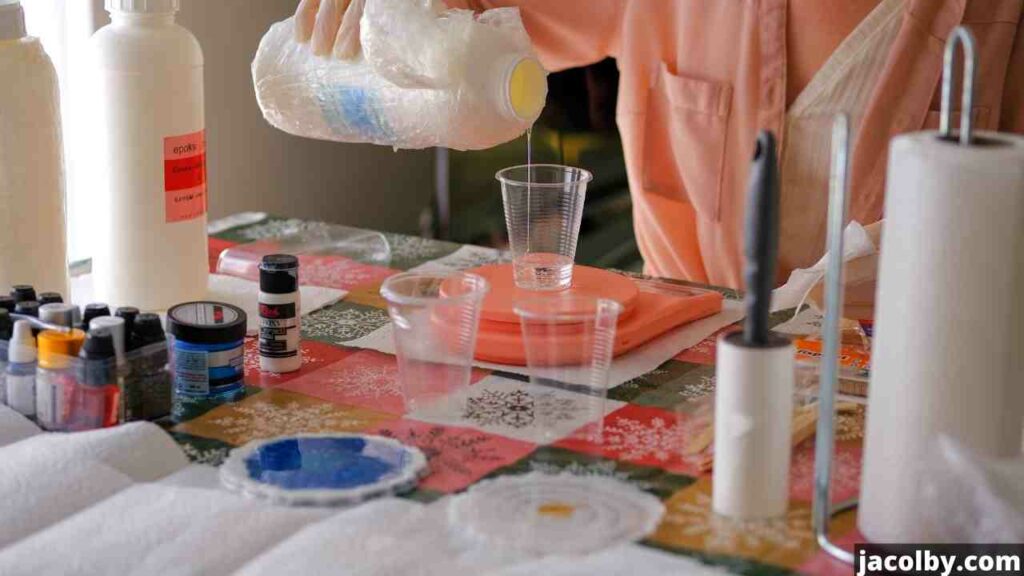
Epoxy resin is now enjoying a surge in popularity among enthusiasts due to its remarkable adaptability.
The term “projects” may refer to a wide variety of tiny concepts, such as making art or jewelry. Still, it can also refer to major tasks, such as installing flooring or repairing boats.
Because there are so many different manufacturers producing such a wide array of items, it will be pretty challenging to select the one that will work best for the project you are working on.
Suppose you are interested in purchasing high-temperature Epoxy. The issue becomes even more difficult for you in that case, so look at these best heat-resistant epoxy resins for perfect results.
Table of Contents
Is Epoxy Resin Capable of Withstanding Heat?
Now, to address the meat and potatoes of the question: Epoxy Resin is; however, this particular kind of resin is subject to a few requirements and restrictions.
When exposed to high temperatures, a DIY epoxy resin considered simple or conventional will begin to deform. This kind of epoxy resin is often used for less ambitious undertakings.
Epoxy resin that can withstand high temperatures is a whole new substance. Epoxy that can tolerate greater temperatures without experiencing any deformation is called high-temperature Epoxy.
It is often used in settings where this property is required. You may also find a variety of heat-resistant resin materials on the market, and anybody is free to use them.
These items are freely accessible. These materials are designed to be used in more compact projects, such as coasters, that are subjected to a certain heat level.
Epoxy Resin’s Value as a Heat-Resistant Binder –

A high-temperature epoxy resin, a specifically developed product that can resist temperatures of up to 450 degrees Fahrenheit and cures even under high-heat circumstances, is often used by manufacturers who operate in challenging situations.
Other desirable qualities of high epoxies include the following:
1. Durability
2. Strong resilience to wear and tear
3. Excellent clarity
4. Low shear rate
5. Conductivity to heat or cold
6. Dimensional consistency even at very high temperatures
When combined with aramid or carbon fiber, the wetting qualities of these epoxy resins are of an extraordinary level. They have a high level of chemical resilience and can be exposed to steam without breaking down.
In addition, because of their excellent thermal conductivity, high-temperature epoxies are a superb option for encapsulation and potting applications.
How much heat is Epoxy able to tolerate before it begins to break down?
Epoxy can withstand temperatures of up to 150 degrees Celsius, or 300 degrees Fahrenheit, for a certain time, but only for a short period.
The maximum temperature heat-resistant epoxy can tolerate depends on the manufacturer and product.
Can epoxy resin be poured with hot objects, as the discussion is about heated temperatures? You’ve got the answers, so check out the article I’ve just written.
Side effects of Traditional Epoxy –

Epoxy has several extra benefits, such as its being resistant to heat. Still, in addition to those benefits, it is also associated with several side effects.
Epoxy stays durable in most circumstances that are encountered in everyday life; nonetheless, its polymer matrix’s breakdown might occur as a result of high heat or heat mixed with moisture.
1. Heat-Related Effects –
Even after being softened to room temperature, many epoxies maintain their strong properties, such as fracture toughness, exhibited at lower temperatures.
However, when exposed to high heat, Epoxy reveals its viscoelastic qualities. Dispersion of heat happens between 68 and 195 degrees Fahrenheit (20 and 90 degrees Celsius).
Epoxy loses both flexural and compressive strength at elevated temperatures. Epoxy achieves its Heat Distortion Temperature (HDT) to the point of deformation at about 60 degrees Celsius.
The glass transition temperature of Epoxy is directly proportional to its HDT. When heated to 90 °C, a material’s properties change and become more ductile.
When temperatures rise, load-bearing capability and stiffness both decrease. As a result, epoxies degrade when exposed to high temperatures.
You must think that learning about heat-resistant epoxy is exciting! Add a little additional sparkle to the mix. What if I say whether making epoxy resistant to heat is feasible? Read the article for further details.
2. The Impact of Humidity and Temperature –

The epoxy-based materials deteriorate when exposed to the elements. An epoxy matrix may be damaged by UV rays, moisture, and heat exposure.
The Epoxy’s flexural strength and other critical mechanical qualities are compromised.
Epoxy plasticizes and expands at ambient temperature with 95% relative humidity, which only worsens as the temperature rises.
Epoxy maintains its strength in conditions of moderate temperature and low relative humidity. It’s because polymer composites take in water from the atmosphere, which causes this effect.
How much moisture an epoxy absorbs is determined by the kind of hardener used and the curing process. This plasticizing process moves forward considerably more quickly when the temperature is elevated.
Epoxy’s mechanical qualities are enhanced through cross-linking, which is only possible under low humidity conditions.
Advice on Using Epoxy Resin That Can Withstand High Temperatures –
Remember, as stated previously, that the most remarkable outcomes are achieved strictly according to the offered directions.
To get the desired outcome, you must strictly adhere to the instructions. Don’t waste time mixing more than you need; instead, focus on getting the job done well.
1. Time is often crucial during the procedure. Therefore it’s essential to be ready in advance.
2. Keep your back from hurting by ensuring your work table is at the right height.
3. Before you start, get some isopropyl alcohol on a cloth and use it to wipe away any dust on the surface.
4. Mixing more precisely and uniformly requires the use of a timer.

5. The ambient temperature and humidity may impact the product quality in the workshop. If the Epoxy becomes too warm, it will become sticky or waxy. It is possible to reduce the likelihood of this occurring at lower temperatures by warming the resin before combining it with the hardener.
6. A trowel or other leveling instrument is needed on broad, flat areas to distribute the epoxy mixture evenly.
7. If you decide to use a paintbrush, invest in a high-quality one that won’t lose its bristles mid-project. If possible, use a black brush so that you can readily see any stray bristles and pick them out of the paint.
8. Always move away from your work while the blow torch heats up. This will keep dust and other particles from settling on your work rather than being blown away.
9. You should let your resin creations cure in a dust-free area.
10. Epoxy’s chemical characteristics are altered when you add additives like colors or granules. This lowers its heat resistance and diminishes its non-toxicity. Incorporate a transparent top layer for the safe placement of hot items.
11. Clean up with acetone after working with wet Epoxy. It may be removed from the floor by heating it with a blowtorch and scraping it with a screwdriver.
FAQs –
Does Craft Resin Hold Up Well Under Heat?
A.1 Epoxy Craft Resin may be used to make coasters without breaking down under the heat. After 21 days, Craft Resin creations reach 200 degrees Fahrenheit (93 degrees Celsius).
Epoxy resin that has cured may become malleable at these temperatures, but it will harden as it cools back down. You may prevent your creation from hardening into an irregular form by chilling it on a flat, level surface if it softens.
Adding more than 6% of a colorant to Craft Resin will disrupt the chemical reaction necessary for the resin’s heat resistance and may even cause the resin to fail.
Is it Possible to Lower the Epoxy’s Temperature Limits?
A.2 High-temperature epoxy resin may indeed experience a reduction in its heat resistance if specific conditions are met.
If the exact ratio of hardener to resin is not used while mixing the resin, the qualities of the resin, especially its resistance to heat, may be altered.
The precise ratio of hardener to resin must be used. Always make sure you carefully follow the blending instructions.
Does the phrase “flame resistant” refer to the same thing as “flame retardant”?
A.3 Yes. The phrases “resistant” and “retardant” are the key to understanding the distinction between “flame” and “fire,” which are sometimes used interchangeably.
If a substance is “flame resistant,” it won’t melt or leak even when subjected to high temperatures and won’t catch fire.
Flame-resistant materials can catch fire, although this is quite unlikely; in fact, many flame-resistant materials would suffocate a fire to the point where it is extinguished.
Chemically prepared to extinguish themselves in the event of a fire, “flame retardant” materials are safe for use in various settings.
If there’s a fire, it’ll release gasses to put it out. Fire retardant chemicals are often applied to plastics and furniture to lessen the likelihood of a fire spreading.
Conclusion –
As was previously discussed, selecting and purchasing the finest-resistant Epoxy involves several considerations. To improve the look of any surface, the heat-resistant resin is a versatile substance with many potential uses.
But remember that the resin must be blended in the precise ratio for the most significant outcomes, and other additions may lessen its efficacy.